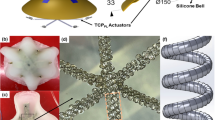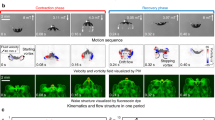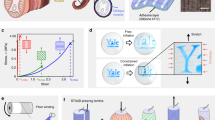Abstract
Reverse engineering of biological form and function requires hierarchical design over several orders of space and time. Recent advances in the mechanistic understanding of biosynthetic compound materials1,2,3, computer-aided design approaches in molecular synthetic biology4,5 and traditional soft robotics6,7, and increasing aptitude in generating structural and chemical microenvironments that promote cellular self-organization8,9,10 have enhanced the ability to recapitulate such hierarchical architecture in engineered biological systems. Here we combined these capabilities in a systematic design strategy to reverse engineer a muscular pump. We report the construction of a freely swimming jellyfish from chemically dissociated rat tissue and silicone polymer as a proof of concept. The constructs, termed 'medusoids', were designed with computer simulations and experiments to match key determinants of jellyfish propulsion and feeding performance by quantitatively mimicking structural design, stroke kinematics and animal-fluid interactions. The combination of the engineering design algorithm with quantitative benchmarks of physiological performance suggests that our strategy is broadly applicable to reverse engineering of muscular organs or simple life forms that pump to survive.
This is a preview of subscription content, access via your institution
Access options
Subscribe to this journal
Receive 12 print issues and online access
$209.00 per year
only $17.42 per issue
Buy this article
- Purchase on Springer Link
- Instant access to full article PDF
Prices may be subject to local taxes which are calculated during checkout




Similar content being viewed by others
References
Mitragotri, S. & Lahann, J. Physical approaches to biomaterial design. Nat. Mater. 8, 15–23 (2009).
Place, E.S., Evans, N.D. & Stevens, M.M. Complexity in biomaterials for tissue engineering. Nat. Mater. 8, 457–470 (2009).
von der Mark, K., Park, J., Bauer, S. & Schmuki, P. Nanoscale engineering of biomimetic surfaces: cues from the extracellular matrix. Cell Tissue Res. 339, 131–153 (2010).
Kaznessis, Y.N. Models for synthetic biology. BMC Syst. Biol. 1, 47 (2007).
Fu, P. A perspective of synthetic biology: assembling building blocks for novel functions. Biotechnol. J. 1, 690–699 (2006).
Bar-Cohen, Y. EAP as artificial muscles: progress and challenges. Proc. SPIE 5385, 10–16 (2004).
Bar-Cohen, Y. Biomimetics–using nature to inspire human innovation. Bioinspir. Biomim. 1, P1–P12 (2006).
Grosberg, A. et al. Self-organization of muscle cell structure and function. PLOS Comput. Biol. 7, e1001088 (2011).
Alford, P.W., Feinberg, A.W., Sheehy, S.P. & Parker, K.K. Biohybrid thin films for measuring contractility in engineered cardiovascular muscle. Biomaterials 31, 3613–3621 (2010).
Huang, A.H., Farrell, M.J. & Mauck, R.L. Mechanics and mechanobiology of mesenchymal stem cell-based engineered cartilage. J. Biomech. 43, 128–136 (2010).
Arai, M.N. A Functional Biology of Scyphozoa (Springer; 1997).
Anderson, P.A.V. & Schwab, W.E. The organization and structure of nerve and muscle in the jellyfish Cyanea capillata (coelenterata; scyphozoa). J. Morphol. 170, 383–399 (1981).
Dabiri, J.O., Colin, S.P., Costello, J.H. & Gharib, M. Flow patterns generated by oblate medusan jellyfish: field measurements and laboratory analyses. J. Exp. Biol. 208, 1257–1265 (2005).
Costello, J.H. & Colin, S.P. Flow and feeding by swimming scyphomedusae. Marine. Biol. 124, 399–406 (1995).
Feitl, K.E., Millett, A.F., Colin, S.P., Dabiri, J.O. & Costello, J.H. Functional morphology and fluid interactions during early development of the scyphomedusa Aurelia aurita. Biol. Bull. 217, 283–291 (2009).
Nawroth, J.C., Feitl, K.E., Colin, S.P., Costello, J.H. & Dabiri, J.O. Phenotypic plasticity in juvenile jellyfish medusae facilitates effective animal-fluid interaction. Biol. Lett. 6, 389–393 (2010).
Gladfelter, W.G. A comparative analysis of the locomotory systems of medusoid Cnidaria. Helgol. Wiss. Meeresunters. 25, 228–272 (1973).
Widmer, C.L. How to Keep Jellyfish in Aquariums: An Introductory Guide for Maintaining Healthy Jellies (Wheatmark; 2008).
Gladfelter, W.B. Structure and function of the locomotory system of the Scyphomedusa Cyanea capillata. Marine Biol. 14, 150–160 (1972).
Passano, L.M. Pacemakers and activity patterns the medusae: homage to Romanes. Am. Zool. 5, 465–481 (1965).
Satterlie, R.A. Neuronal control of swimming in jellyfish: a comparative story. Can. J. Zool. 80, 1654–1669 (2002).
Koehl, M.A. et al. Lobster sniffing: antennule design and hydrodynamic filtering of information in an odor plume. Science 294, 1948–1951 (2001).
Koehl, M.A.R. Biomechanics of microscopic appendages: functional shifts caused by changes in speed. J. Biomech. 37, 789–795 (2004).
Chapman, D.M. Microanatomy of the bell rim of Aurelia aurita (Cnidaria: Scyphozoa). Can. J. Zool. 77, 34–46 (1999).
Blanquet, R.S. & Riordan, G.P. An ultrastructural study of the subumbrellar musculature and desmosomal complexes of cassiopea xamachana (Cnidaria: Scyphozoa). Trans. Am. Microsc. Soc. 100, 109–119 (1981).
Hayward, R.T. Modeling Experiments on Pacemaker Interactions in Scyphomedusae. PhD thesis, UNCW 〈http://libres.uncg.edu/ir/uncw/listing.aspx?id=1787〉 (2007).
Grosberg, A., Alford, P.W., McCain, M.L. & Parker, K.K. Ensembles of engineered cardiac tissues for physiological and pharmacological study: heart on a chip. Lab Chip 11, 4165–4173 (2011).
Böl, M., Reese, S., Parker, K.K. & Kuhl, E. Computational modeling of muscular thin films for cardiac repair. Comput. Mech. 43, 535–544 (2008).
Shim, J., Grosberg, A., Nawroth, J.C., Parker, K.K. & Bertoldi, K. Modeling of cardiac muscular thin films: pre-stretch, passive and active behavior. J. Biomech. 45, 832–841 (2012).
Feinberg, A.W. et al. Muscular thin films for building actuators and powering devices. Science 317, 1366–1370 (2007).
Marder, M., Deegan, R. & Sharon, E. Crumpling, buckling, and cracking: elasticity of thin sheets. Phys. Today 60, 33–38 (2007).
Vogel, S. Life in Moving Fluids: the Physical Biology of Flow (Princeton University Press, 1996).
Fedorov, V.V. et al. Application of blebbistatin as an excitation-contraction uncoupler for electrophysiologic study of rat and rabbit hearts. Heart Rhythm 4, 619–626 (2007).
Bayly, P.V. et al. Estimation of conduction velocity vector fields from epicardial mapping data. IEEE Trans. Biomed. Eng. 45, 563–571 (1998).
Bray, M.-A., Sheehy, S.P. & Parker, K.K. Sarcomere alignment is regulated by myocyte shape. Cell Motil. Cytoskeleton 65, 641–651 (2008).
Hamley, I.W. Liquid crystals. in Introduction to Soft Matter: Synthetic and Biological Self-Assembling Materials, pp. 221–273 (John Wiley & Sons, 2007) 〈http://onlinelibrary.wiley.com/doi/10.1002/9780470517338.ch5/summary〉.
Umeno, A. & Ueno, S. Quantitative analysis of adherent cell orientation influenced by strong magnetic fields. IEEE Trans. Nanobioscience 2, 26–28 (2003).
Satheesh, V.K., Chhabra, R.P. & Eswaran, V. Steady incompressible fluid flow over a bundle of cylinders at moderate Reynolds numbers. Can. J. Chem. Eng. 77, 978–987 (1999).
Masliyah, J.H. & Epstein, N. Steady symmetric flow past elliptical cylinders. Ind. Eng. Chem. Fundam. 10, 293–299 (1971).
Halliday, D., Resnick, R. & Walker, J. Fundamentals of Physics (John Wiley and Sons, 2010).
Adrian, R.J. Particle-imaging techniques for experimental fluid mechanics. Annu. Rev. Fluid Mech. 23, 261–304 (1991).
Willert, C.E. & Gharib, M. Digital particle image velocimetry. Exp. Fluids 10, 181–193 (1991).
Abramoff, M., Magelhaes, P. & Ram, S. Image processing with ImageJ. Biophotonics Int. 11, 36–42 (2004).
Acknowledgements
We acknowledge financial support from the Wyss Institute for Biologically Inspired Engineering at Harvard, the Harvard Materials Research Science and Engineering Center under National Science Foundation award number DMR-0213805, US National Institutes of Health grant 1 R01 HL079126 (K.K.P.), and from the office of Naval Research and National Science Foundation Program in Fluid Dynamics (J.O.D.). We acknowledge the Harvard Center for Nanoscale Science for use of facilities and the New England Aquarium for supplying jellyfish. We thank J. Goss, P.W. Alford, K.R. Sutherland, K. Balachandran, C. Regan, P. Campbell, S. Spina and A. Agarwal for comments and technical support.
Author information
Authors and Affiliations
Contributions
K.K.P., J.O.D. and J.C.N. conceived the project, designed the experiments and prepared the manuscript. J.O.D. and J.C.N. developed the fluid model. J.C.N. did the experiments and analyzed the data. H.L., A.W.F., C.M.R., M.L.M. and A.G. supervised experiments, analyzed data and gave conceptual advice. M.L.M. isolated rat cardiomyocytes for experiments.
Corresponding authors
Ethics declarations
Competing interests
The authors declare no competing financial interests.
Supplementary information
Supplementary Text and Figures
Supplementary Methods and Supplementary Figs. 1-8 (PDF 6118 kb)
Supplementary Movie 1
This movie shows the stroke cycle in a free-swimming juvenile Moon jellyfish (Aurelia aurita)consisting of muscle-powered contraction (power stroke) and elastic recoil (recovery stroke) (MOV 4232 kb)
Supplementary Movie 2
This movie shows the failure of a biomimetic Medusoid design to propel itself. The Medusoidconstruct was paced at 1 Hz through an externally applied monophasic square pulse (2.5V/cm,10ms duration). Due to mismatch of muscle stresses and substrate compliance, musclecontraction does not result in sufficient bell deformation, and no thrust is generated (MOV 1473 kb)
Supplementary Movie 3
This movie demonstrates jellyfish-like body contraction and free-swimming of optimallydesigned Medusoid constructs. Medusoids were paced at 1 Hz through an externally appliedmonophasic square pulse (2.5V/cm, 10ms duration). The first scene shows a mature constructstill attached at its center to its casting mold, just prior to release. (Note that the striatedappearance of the casting mold is caused by its fabrication process; in particular, this striationdoes not reflect the alignment of the muscle tissue on top of the silicone membrane covering themold). Subsequent scenes show exemplary propulsion of free-swimming Medusoids (MOV 5675 kb)
Supplementary Movie 4
This movie demonstrates comparative propulsion efficacy (distance per stroke) in jellyfish andoptimal Medusoids, whereas suboptimal Medusoids (“sieve design”) exhibit inferiorperformance. While Medusoids were paced at 1 Hz through an externally applied electric field of6 V, here the jellyfish contracts at a frequency of ca. 2 Hz. In order to facilitate comparison, theframe rate of the jellyfish recording was halved to synchronize stroke phases (MOV 2731 kb)
Supplementary Movie 5
This movie shows a sequence of raw DPIV data for jellyfish, Medusoid and suboptimally (=sieve-) designed Medusoids. Here, fluid flow around the jellyfish/Medusoid bell is visualized by the displacement of neutrally buoyant particles suspended within the fluid and illuminatedwithin a single plane using laser light. The relative motion of the particles allows quantifying 2Dfluid flow within the plane (MOV 2997 kb)
Supplementary Movie 6
This movie shows the fluid flow field and the vorticity field of a juvenile jellyfish during thestroke cycle. The movie was generated from DPIV data. The power stroke is characterized bymaximal fluid velocities and formation of a starting vortex, generating thrust. The recoverystroke is characterized by reduced fluid velocities and the formation of a stopping vortex,generating feeding currents towards the subumbrellar side (MOV 5745 kb)
Supplementary Movie 7
This movie shows the fluid flow field and the vorticity field of an optimally designed Medusoidduring the stroke cycle. The movie was generated from DPIV data. As in the jellyfish, the powerstroke generates maximal fluid velocities and a starting vortex ring, resulting in thrust. Therecovery stroke generates a stopping vortex ring that draws feeding currents towards the subumbrella (MOV 4993 kb)
Supplementary Movie 8
This movie shows the fluid flow field and the vorticity field of a suboptimal Medusoid design.The movie was generated from DPIV data. In contrast to jellyfish and optimal Medusoids,suboptimal Medusoids with “sieve design” fail to sufficiently accelerate fluid during the powerstroke, resulting in poor thrust generation. Vorticity patterns are more diffuse compared to thoseobserved in jellyfish and optimal designs, and further flow analysis revealed that generation offeeding currents was inferior as well (Fig. 4) (MOV 6131 kb)
Rights and permissions
About this article
Cite this article
Nawroth, J., Lee, H., Feinberg, A. et al. A tissue-engineered jellyfish with biomimetic propulsion. Nat Biotechnol 30, 792–797 (2012). https://doi.org/10.1038/nbt.2269
Received:
Accepted:
Published:
Issue Date:
DOI: https://doi.org/10.1038/nbt.2269
This article is cited by
-
Effect of Active–Passive Deformation on the Thrust by the Pectoral Fins of Bionic Manta Robot
Journal of Bionic Engineering (2024)
-
Jelly-Z: swimming performance and analysis of twisted and coiled polymer (TCP) actuated jellyfish soft robot
Scientific Reports (2023)
-
Skeletal muscle cells opto-stimulation by intramembrane molecular transducers
Communications Biology (2023)
-
Ontogenetic transitions, biomechanical trade-offs and macroevolution of scyphozoan medusae swimming patterns
Scientific Reports (2023)
-
This cyborg cockroach could be the future of earthquake search and rescue
Nature (2023)



